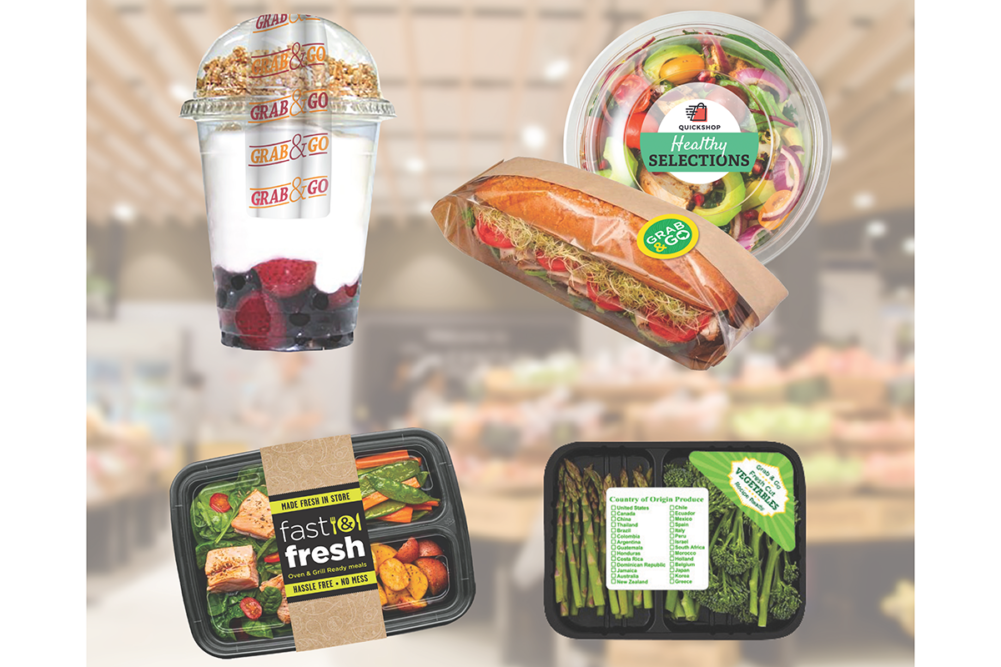One of the top things on the to-do list for Toledo, Ohio-based Bollin Label Systems this year is to improve its speed to market, said Helen Darrah, the company’s executive director of sales and marketing.
“We’ve been prioritizing investments both in equipment and software, improving the press capabilities we’re able to offer our customers,” Darrah said.
Bollin labels can be customized with unique messaging and branding and even personalized for individual customers.
The company has seen multiple new business opportunities where it’s able to work one-on-one with its customers on brand development. Updating label designs to include personalized elements, Darrah said, can help products connect with consumers on a more individual level.
The labeling of products sold in grocery fresh departments is constantly evolving, driven by factors including changing consumer preferences, health and safety concerns and government regulations.
“Overall, labeling trends in the fresh grocery departments are driven by consumer demand for transparency, health, sustainability and convenience,” Darrah said. “We can design and produce labels that cover these needs. Our label experts work to stay knowledgeable and up to date on all the latest in printing technologies, which will be of benefit when helping customer incorporate those trends in their new labeling projects.”
Bollin’s eight labeling trends
1. Convenience
Today’s consumers are often in a hurry. Whether it’s rushing to a meeting or an appointment, it’s no wonder the idea of picking up a quick, ready-made meal has become more appealing. This rise of grab-and-go sections is a significant source of revenue growth for supermarkets. That’s good news for both the industry and consumers, who now have even more meal options. But it also creates obstacles and compliance issues for grocers. When a grocer offers ready-made food, it’s required by law to attach nutrition facts labels to each item that details weight, serving size, ingredients, food allergens, and an expiration date. Bollin Label offers label solutions for grab-and-go and fresh meal kits. Labels can also be used to display the price of the product, offer a promotional message, and provide cooking or heating instructions.
2. Nutritional labeling
Nutritional labeling has been a requirement for packaged foods for many years, but there is now a trend toward providing this information for fresh foods, prepared grab-and-go items, and meal kits as well. Busy consumers are still health conscious and want transparency in food labeling. The top four considerations are calories, total sugar, sodium and serving size.
3. Labeling for dietary preferences
With an increasing number of people following specialized diets, such as vegan, vegetarian, keto, or gluten-free, there is a trend toward labeling products with dietary preference information to help consumers make informed choices.
4. Clean and clear labeling
Consumers are increasingly looking for products with simple and easily understandable ingredient lists and are wary of artificial additives and preservatives. As a result, many of Bollin’s processor customers are simplifying their ingredient lists and using clear and concise language on their labels.
5. Allergen labeling
With the rise of food allergies and intolerances, many consumers are looking for clear and prominent labeling of allergens on food products to ensure they keep themselves and their families safe. This includes not just the common allergens like peanuts and gluten, but also lesser-known allergens like sesame and mustard. Labels can help customers make informed choices about what they can safely serve and eat.
6. Sustainability labeling
Many consumers are now concerned about the environmental impact of their food choices and are looking for products that are sustainably produced and packaged. This has led to the rise of labels like “organic,” “fair trade” and “locally sourced.” Darrah said Bollin has seen an uptick in customer requests for label designs that incorporate those types of statements for their brands.
7. Country of origin labeling
Consumers are increasingly interested in knowing where their food comes from, and country of origin labeling is becoming more common on fresh produce, meat and seafood.
8. QR codes
QR codes can be used on labels of prepared and fresh foods in a supermarket to provide customers with a range of information and services that can enhance their shopping experience and help them make informed choices about the products they buy. This could be accessing nutritional information, providing a recipe; sharing product origin and information; offering discounts and promotions; providing product reviews and ratings; and tracking product recalls.
FDA revamps food label recommendations
Promoting good nutrition and greater label consistency and helping consumers make informed choices are among the top new food labeling recommendations from the U.S. Food and Drug Administration.
The agency also said it’s moving forward with additional nutrition and labeling priorities, including exploring a “front-of-pack” labeling initiative and recommendations for nutrition labeling for online grocery shopping sites.
The agency’s guidance provides food manufacturers with recommendations on how and when to use Dietary Guidance Statements on the label of food products. It’s part of the FDA’s overall goal to help reduce the burden of chronic disease and advance health equity through improved nutrition.
“Like other labeling statements and claims, Dietary Guidance Statements act as quick signals on food packages to help consumers better understand nutrition information and make healthier food choices,” according to the FDA.
The FDA will also begin assessing further strategies to reduce added sugar consumption, which includes collaborating with others in the U.S. Department of Health and Human Services and the U.S. Department of Agriculture to hold a public meeting regarding future steps the federal government could take to reduce intake of added sugars.

